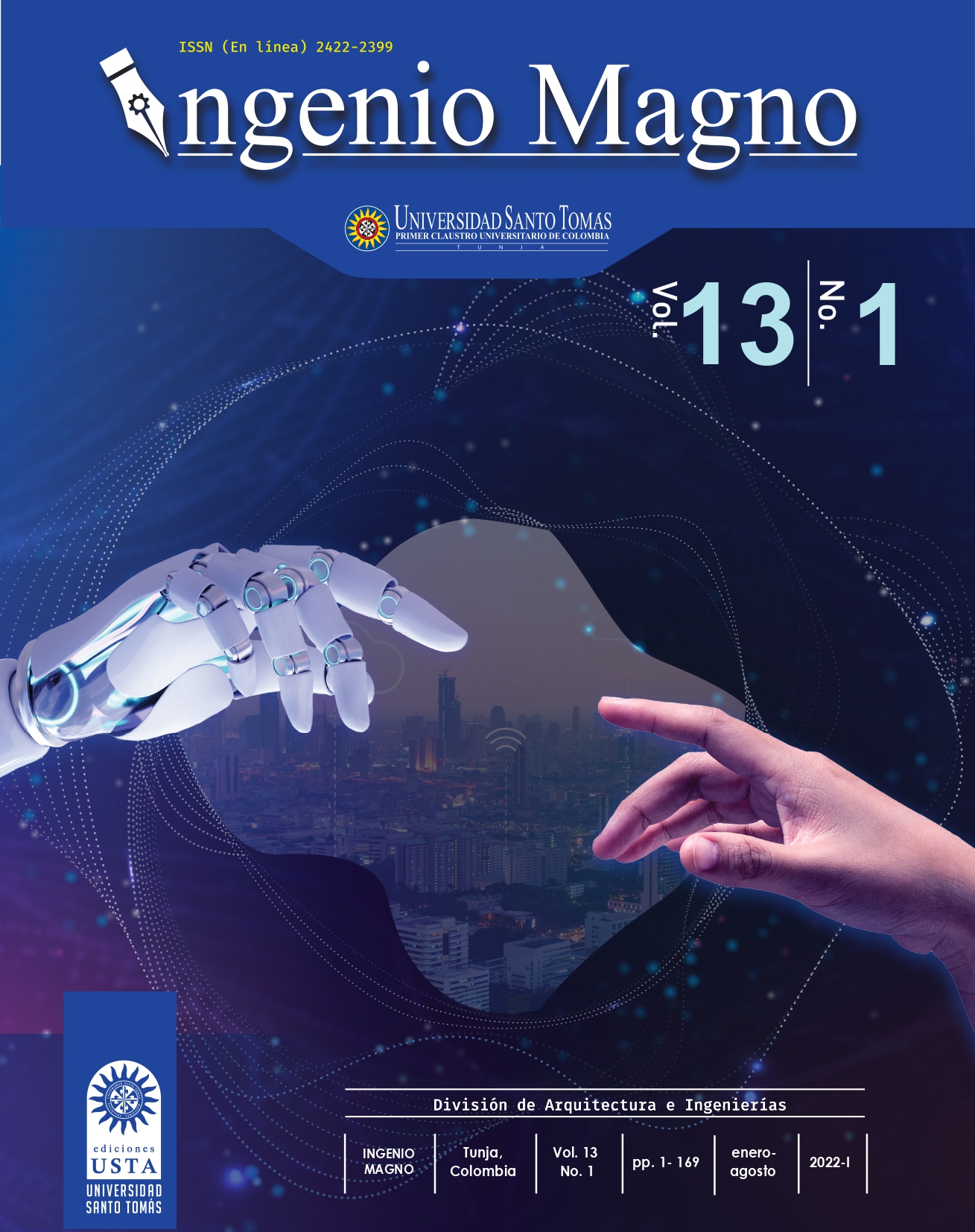Steam as an approach for interactive learning of computer-aided design
Main Article Content
Abstract
Downloads
Article Details
DECLARATION OF ORGINIALITY OF SUBMITTED ARTICLE
With this document, I/We certify that the article submitted for possible publication in the institutional journal INGENIO MAGNO of the Research Center Alberto Magno CIIAM of the University Santo Tomás, Tunja campus, is entirely of my(our) own writing, and is a product of my(our) direct intellectual contribution to knowledge.
All data and references to completed publications are duly identified with their respective bibliographical entries and in the citations thus highlighted. If any adjustment or correction is needed, I(we) will contact the journal authorities in advance.
Due to that stated above, I(we) declare that the entirety of the submitted material is in accordance with applicable laws regarding intellectual and industrial property, and therefore, I(we) hold myself(ourselves) responsible for any complaint related to it.
If the submitted article is published, I(we) declare that I(we) fully relinquish publishing rights of the article to the University Santo Tomás, Tunja campus. As remuneration for this relinquishment of rights, I(we) declare my(our) agreement to receive two (2) copies of the edition of the journal in which my(our) article appears.
References
[2] Jho, Hong & Song (2016). An Analysis of STEM/STEAM Teacher Education in Korea with a Case Study of Two Schools from a Community of Practice Perspective. https://www.researchgate.net/ publication/301682198_An_Analysis_ of_STEMSTEAM_Teacher_Education_ in_Korea_with_a_Case_Study_of_ Two_Schools_from_a_Community_of_ Practice_Perspective
[3] Rivera Muñoz, J. L. (2014). El aprendizaje significativo y la evaluación de los aprendizajes. Revista de Investigación Educativa, 8(14). https://revistasinvestigacion. unmsm.edu.pe/index.php/educa/ article/view/7098/6272
[4] Barrera Siabato, A. I. ., & Ávila Moreno, J. P. (2020). Uso de herramientas de la industria 4.0 en instituciones educativas rurales de Yopal como estrategia para la identificación de competencias personales y técnicas. Publicaciones E Investigación, 14(1). https://doi. org/10.22490/25394088.4053
[5] National Education Association. (2012). Preparing 21st-century students for a global society: An educator’s guide to “the four Cs.” Washington, DC: Author. Available: http://www.nea.org/assets/ docs/A-Guide-to-Four-Cs.pdf.
[6] Caplan, M. y Cifuentes, A.P. (2019). Promoviendo la educación STEAM en áreas rurales a través de la STEAM Conference – Una experiencia piloto. Virtual Educa. Lima, Perú.
[7] Ochoa Duarte, Alexei & León, Leonardo & Reina-Rozo, Juan. (2021). STEAM, sociedad y extensión universitaria en Colombia: Una propuesta preliminar desde el Buen Vivir. Sociología y Tecnociencia. 11. 55-82. 10.24197/st.Extra_1.2021.55-82.
[8] Observatorio Laboral para la Educación OLE del Ministerio de Educación Nacional en Colombia. https://ole.mineducacion.gov.co/ portal/
[9] Burnaford, G. Brown, S. Doherty, J. y McLaughlin H.J. (2007). Arts Integration. Frameworks, Research, and. Practice: A Literature Review. Washington:_Arts Education Patnership. Recuperado de: http://www.eugenefieldaplus. com/academics/A+%20research/ artsintegration.pdf
[10] Roig-Vila, Rosabel (ed.). Tecnología, innovación e investigación en los procesos de enseñanza-aprendizaje. Barcelona: Octaedro, 2016. ISBN 978- 84-9921-848-9, 3173 p.
[11] Implementation of a STEAM project in compulsory secondary education that creates connections with the environment. Miguel Ángel Queiruga Dios, Emilia López-Iñesta, María Diez Ojeda, María Consuelo Sáiz Manzanares, José Benito Vázquez Dorrío. Journal for the Study of Education and Development, Infancia y Aprendizaje, ISSN 0210- 3702, ISSN-e 1578-4126, Vol. 44, Nº 4, 2021 (Ejemplar dedicado a: Special issue: STEAM education: Contributing evidence of validity and effectiveness / Número especial: Educación STEAM: Aportando pruebas de validez y efectividad), págs. 871-908
[12] Hernández, S. R., Fernández, C. C., & Baptista, L. P. (2006). Metodología de la investigación (4a. ed.). https:// ebookcent r a l - p roques t - com. bibliotecavirtual.unad.edu.co.
[13] E. Rúa, A. Barrera, N. M. Moreno, “Aprendizaje interactivo de termodinámica de fluidos apoyado en las tecnologías de la información y comunicación”, Respuestas, vol. 19, no. 2, pp. 41-50, 2014.
[14] Gutiérrez, J., Jacob, F., & Gutiérrez, C. (2018). Estrategias didácticas de enseñanza y aprendizaje desde una perspectiva interactiva. Journal of Chemical Information and Modeling, 53(9), 1689-1699. https://doi. org/10.1017/CBO9781107415324.004
[15] Carrera, C., & Marín, R. (2011). Modelo pedagógico para el desarrollo de competencias en educación superior. Actualidades Investigativas En Educación, 11(1), 1-32. https://doi. org/10.15517/aie.v11i1.10183
[16] Gómez, L., & Macedo, J. (2010). Importancia de las TIC en la en la educación. Tecnología de la información. Investigación Educativa, 14(25), 209-224. http:// revistasinvestigacion.unmsm.edu. p e / i n d e x . p h p / e d u c a / a r t i c l e / view/4776/3850
[17] Fuertes, A.; Ferrís , R & Grimaldo, F. (2018). “¿Un cambio de metodología que aumente la satisfacción y motivación del estudiante favorece su aprendizaje? Experiencias en el aula”, Actas de las Jenui, vol. 3, núm. 1. https://www.uv.es/grimo/publications/ jenui2018.pdf
[18] Saulés, S. (2012). La competencia lectora en PISA. Influencias, innovaciones y desarrollo. México: Instituto Nacional para la Evaluación de la Educación. https://www.redalyc. org/pdf/5534/553457067008.pdf
[19] Díaz, B, F. 2005. El aprendizaje basado en problemas y el método de casos. En: Enseñanza situada: Vínculo entre la escuela y la vida. México: McGraw Hill. [20] Restrepo, B., Aprendizaje Basado en Problemas (ABP): Una Innovación Didáctica para la Enseñanza Universitaria. Educación y Educadores, 8, (2005).

